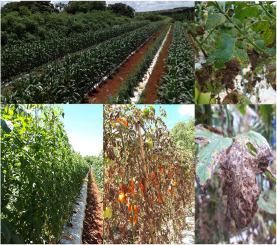当前位置:
X-MOL 学术
›
Crop Prot.
›
论文详情
Our official English website, www.x-mol.net, welcomes your
feedback! (Note: you will need to create a separate account there.)
Field validation of TOMCAST modified to manage Septoria leaf spot on tomato in the central-west region of Brazil
Crop Protection ( IF 2.5 ) Pub Date : 2020-12-01 , DOI: 10.1016/j.cropro.2020.105333 Mylla Crysthyan Ribeiro Ávila , Valdir Lourenço , Alice Maria Quezado-Duval , Walter Ferreira Becker , Monita Fiori de Abreu-Tarazi , Lino Carlos Borges , Abadia dos Reis Nascimento
Crop Protection ( IF 2.5 ) Pub Date : 2020-12-01 , DOI: 10.1016/j.cropro.2020.105333 Mylla Crysthyan Ribeiro Ávila , Valdir Lourenço , Alice Maria Quezado-Duval , Walter Ferreira Becker , Monita Fiori de Abreu-Tarazi , Lino Carlos Borges , Abadia dos Reis Nascimento

|
Abstract Septoria leaf spot, caused by Septoria lycopersici, is a devastating disease on tomato in Brazil. In order to rationalize the chemical control, we validated the TOMCAST system to manage Septoria leaf spot on fresh market tomato in the State of Goias, Brazil. Three field experiments were performed in a randomized complete block with five treatments and four replications. The first experiment was carried out from October 2017 to February 2018, the second from October 2018 to February 2019, and the third from November 2018 to March 2019. The treatments evaluated were: 1. Weekly calendar application of fungicides (WCA); 2 to 4. Disease severity values (DSV) 15, 20, and 25; 5. Control: plants not treated with fungicides. The values of the average air temperature and leaf wetness were used to calculate the DSV. The environmental conditions were favorable to the disease in experiments. The lowest values of the area under the disease progress curve (AUDPC) were recorded in WCA (809), DSV 20 (837), and DSV 15 (842) in the first experiment. Disease rates (r) of 0.010 were estimated in these treatments. Highest AUDPC (1325) and r (0.013) were detected in the control. In the second and third experiments, the highest AUDPC values were 638 and 59 in the control, respectively. The lowest AUDPC values were recorded in DSV 15 and WCA which were 325 and 28, 349 and 26, in the second and third experiments, respectively. No differences of r were detected in the second and third experiments. The highest number of fruits by plant (15) was estimated in DSV 15 in the second experiment. There were no differences on tomato yield in other experiments. As the number of fungicides applications was the highest in DSV 15, the TOMCAST system is not a useful tool for controlling Septoria leaf spot on tomato in the State of Goias and other Brazilian regions with similar climatic characteristics.
中文翻译:

改良 TOMCAST 的田间验证,用于管理巴西中西部地区番茄上的 Septoria 叶斑病
摘要 番茄叶斑病(Septoria lycopersici) 是巴西番茄的一种毁灭性病害。为了使化学控制合理化,我们验证了 TOMCAST 系统来管理巴西戈亚斯州新鲜市场番茄上的 Septoria 叶斑病。在随机完整区组中进行了三个田间试验,五个处理和四个重复。第一次实验于2017年10月至2018年2月进行,第二次于2018年10月至2019年2月进行,第三次于2018年11月至2019年3月进行。2 到 4。疾病严重度值 (DSV) 15、20 和 25;5. 对照:未用杀菌剂处理的植物。平均气温和叶片湿度的值用于计算 DSV。实验中的环境条件有利于该病害发生。在第一个实验中,疾病进展曲线下面积 (AUDPC) 的最低值记录在 WCA (809)、DSV 20 (837) 和 DSV 15 (842) 中。在这些治疗中,估计发病率 (r) 为 0.010。在对照中检测到最高的 AUDPC (1325) 和 r (0.013)。在第二个和第三个实验中,对照中最高的 AUDPC 值分别为 638 和 59。最低的 AUDPC 值记录在 DSV 15 和 WCA 中,在第二个和第三个实验中分别为 325 和 28、349 和 26。在第二个和第三个实验中没有检测到 r 的差异。在第二个实验中,在 DSV 15 中估计了植物的最高果实数量 (15)。在其他实验中番茄产量没有差异。
更新日期:2020-12-01
中文翻译:

改良 TOMCAST 的田间验证,用于管理巴西中西部地区番茄上的 Septoria 叶斑病
摘要 番茄叶斑病(Septoria lycopersici) 是巴西番茄的一种毁灭性病害。为了使化学控制合理化,我们验证了 TOMCAST 系统来管理巴西戈亚斯州新鲜市场番茄上的 Septoria 叶斑病。在随机完整区组中进行了三个田间试验,五个处理和四个重复。第一次实验于2017年10月至2018年2月进行,第二次于2018年10月至2019年2月进行,第三次于2018年11月至2019年3月进行。2 到 4。疾病严重度值 (DSV) 15、20 和 25;5. 对照:未用杀菌剂处理的植物。平均气温和叶片湿度的值用于计算 DSV。实验中的环境条件有利于该病害发生。在第一个实验中,疾病进展曲线下面积 (AUDPC) 的最低值记录在 WCA (809)、DSV 20 (837) 和 DSV 15 (842) 中。在这些治疗中,估计发病率 (r) 为 0.010。在对照中检测到最高的 AUDPC (1325) 和 r (0.013)。在第二个和第三个实验中,对照中最高的 AUDPC 值分别为 638 和 59。最低的 AUDPC 值记录在 DSV 15 和 WCA 中,在第二个和第三个实验中分别为 325 和 28、349 和 26。在第二个和第三个实验中没有检测到 r 的差异。在第二个实验中,在 DSV 15 中估计了植物的最高果实数量 (15)。在其他实验中番茄产量没有差异。











































 京公网安备 11010802027423号
京公网安备 11010802027423号